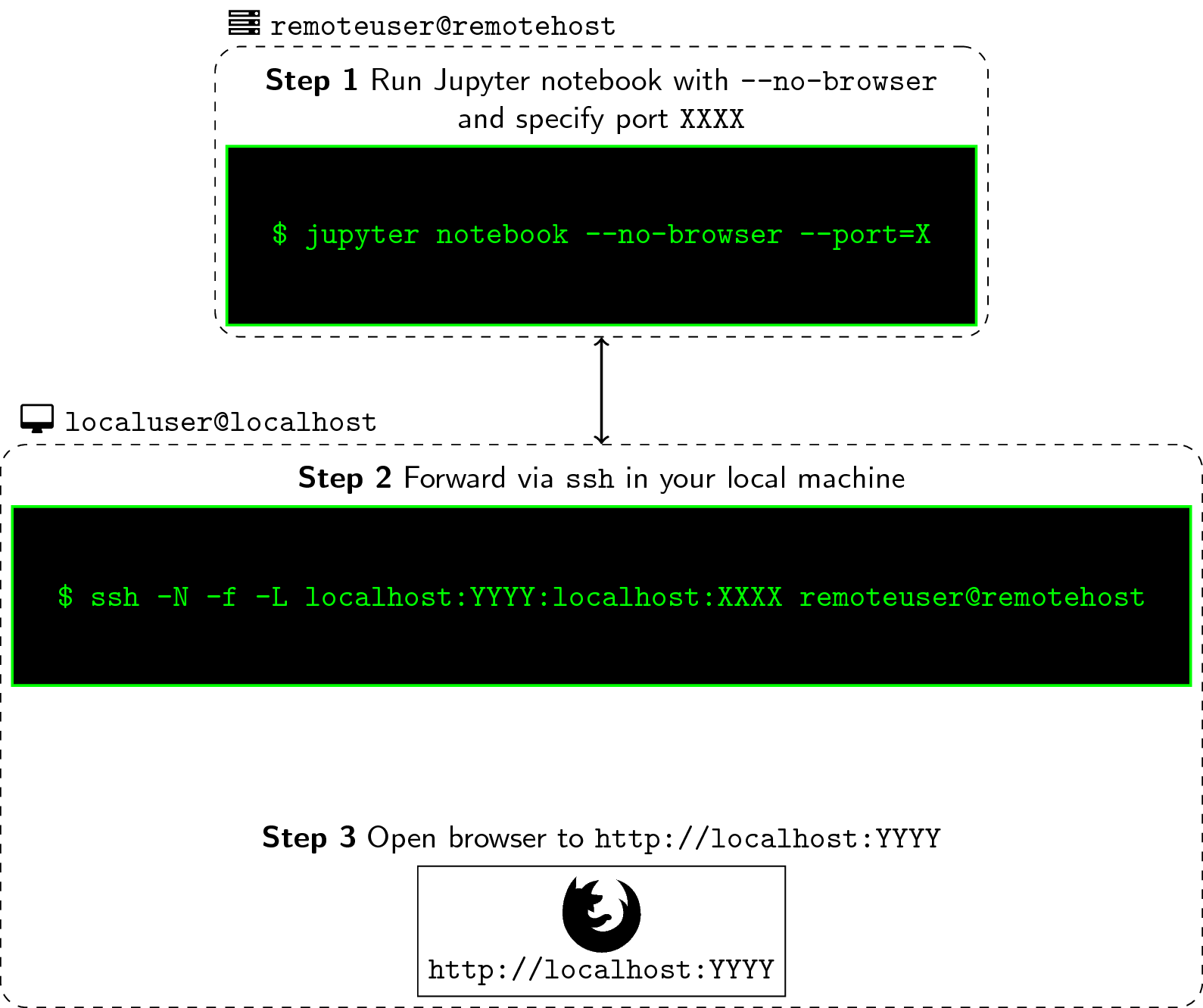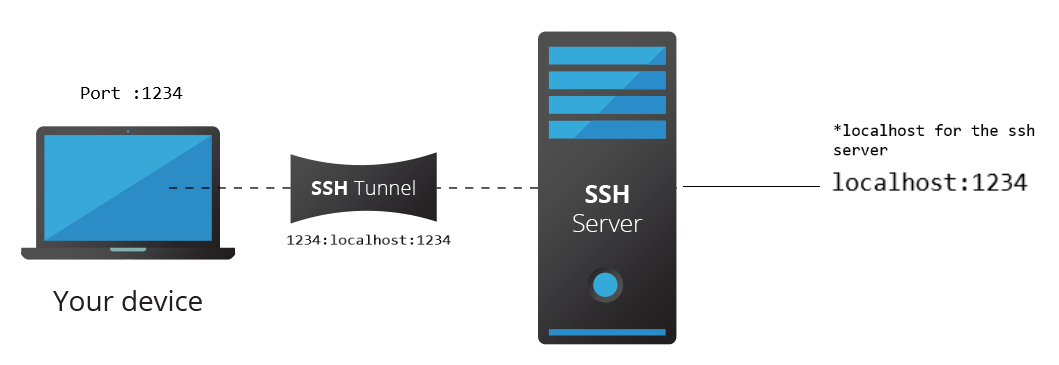I would recommend doing this within a Conda. Log-in to your remote machine the usual way you do.

Running A Jupyter Notebook From A Remote Server
You need to do this having activated the correct python environment.

. Ssh jer remote -machine. You can access the notebook from your remote machine over SSH by setting up a SSH tunnel. This is a Jupyter password.
Ssh into the remote -machine. RUN JUPYTER IN REMOTE SERVER outssh -T usernameserverIP. You can either if you havent set a password insert the token that should be displayed a bunch of letters and numbers in the remote or if you dont see this youll need to set a password.
How To Run An IPythonJupyter Notebook On A Remote. Optional On the remote-machine run tmux. Back out of your running Jupyter notebook on the remote and run jupyter notebook password.
Which jupyter-notebook homeusernamelocalsharevirtualenvsnotebookbinjupyter-notebook optional Step 11. How does a Jupyter notebook work. Set notebook password and any other config.
Run Jupyter Notebook from remote machine. Jupyter notebook --no-browser --port8086. Run Notebook with Specified Port Number.
LocalhostYYYY Again the reason why were opening it at YYYY and not at XXXX is because the latter is already being forwarded to the former. To open up the Jupyter notebook from your remote machine simply start your browser and type the following in your address bar. Ssh into the remote-machine.
Jupyter notebook must be run from your vps so that you can connect to it from your local machine using an ssh tunnel and your favorite web browser. This will prompt you to write and verify a password which. Change XXXX to the port of your choice.
Login to Remote Server. Steps to Run a Remote Jupyter Notebook. Of the remote server to that of your local machine.
Running a Jupyter notebook from a remote server. You can now access the jupyter server. Install jupyter and its dependencies in your home directory.
Replace with your selected port number jupyter notebook no-browser port. Dont forget to change jer and remote-machine to your user and machine name. To function correctly the firewall on the computer running the jupyter notebook server must be configured to allow connections from client machines on the access port cNotebookAppport set in jupyter_notebook_configpy to allow connections to the web interface.
Dont forget to change jer and remote -machine to your user and machine name. Running Jupyter Notebook on a remote server. Localhost8887 you will see your Jupyter notebooks asking for a password token.
Forward port XXXX to YYYY and listen to it. The firewall must also allow connections from 127001 localhost on ports from 49152 to 65535. Launch jupyter notebook from remote server selecting a port number for.
Once the console shows type the following. Log-in to your remote machine the usual way you do. Replace with your username and server address.
In your remote the notebook is now running at the port XXXX that you specified. Fi cd jupyter Create a script to run jupyter echo jupyter notebook --no-browser -. When youre logged into your remote via ssh you can.
Jupyter notebook --no-browser --port9999 On the local machine catch the forwarded port. How do I run a Jupyter notebook over SSH. Jupyter notebook --no-browser --portXXXX Note.
Then copy the token and paste it and login. Find the path to your jupyter-notebook executable. Jupyter on a login node Setup.
Steps to Run Jupyter Notebook Remotely. Forward port XXXX to YYYY and listen to it. In most cases this is simply done via an ssh command.
3 hours ago Updated 7 minutes Feb 01 2022 Once the appropriate environment is activated you can create and open a Jupyter Notebook connect to a remote Jupyter server for running code cells and export a Jupyter Notebook as a Python file. By default the Visual. If your remote session gets disconnected tmux will keep the session running to reconnected run tmux attach.
Ssh -NfL localhost9999localhost9999 your_user_nameremote_ip_address Go to. Usually the default is 8888. How to run Jupyter Notebooks on remote server SSH Using SSH Tunneling Using Reverse Proxy.
The Jupyter Notebook App is a server-client application that allows editing and running notebook documents via a web browser. Launch Jupyter Notebook from remote server selecting a port number for. Just a normal SSH login.
Session Steps to Run a Remote Jupyter Notebook. Jupyter Jupyter Notebook On Remote Server Valuable Reading Resources. In your remote the notebook is now running at the port XXXX that you specified.
Optional On the remote -machine run tmux. Executing this command will start the jupyter notebook server on port 8889 and let it run in the background. You will see the Jupyter Notebook running in your browser while the code in the notebook is executed on the remote server.
The -L flag tells ssh to tunnel the localhost. On the remote machine start jupyter notebook from your current directory and specify the port. Once logged in to the remote server cd to the desired directory and run the following command.

Use Jupyter Notebook Remotely Pytraj 2 0 2 Dev0 Documentation

Tips For Running Jupyter Notebook On Remote Server Just Chillin

How Can Connect Jupyter Notebook In Desired Environment In Anaconda In Server Computer By Using Putty Stack Overflow

Running Jupyter Notebooks On A Remote Server Via Ssh Tech Talk Tone

How To Install Run And Connect To Jupyter Notebook On A Remote Server Digitalocean

How To Install Run And Connect To Jupyter Notebook On A Remote Server Digitalocean

How To Run Jupyter Notebooks On Remote Server Ssh By Pranav Gajjewar Medium

Tips For Running Jupyter Notebook On Remote Server Just Chillin
0 comments
Post a Comment